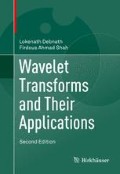Abstract
Multiresolution analysis (MRA) is considered as the heart of wavelet theory. The concept of MRA provides an elegant tool for the construction of wavelets. An MRA is an increasing family of closed subspaces \(\left \{V _{j}: j \in \mathbb{Z}\right \}\) of \(L^{2}(\mathbb{R})\) such that \(\bigcap _{j\in \mathbb{Z}}V _{j} = \left \{0\right \},\,\bigcup _{j\in \mathbb{Z}}V _{j}\) is dense in \(L^{2}(\mathbb{R})\) and which satisfies f ∈ V j if and only if f(2⋅ ) ∈ V j+1. Furthermore, there exists an element ϕ ∈ V 0 such that the collection of integer translates of function \(\upphi,\,\left \{\upphi (\cdot - k): k \in \mathbb{Z}\right \}\) represents a complete orthonormal system for V 0. The function ϕ is called the scaling function or the father wavelet. This classic concept of MRA has been extended in various ways in recent years. These concepts are generalized to \(L^{2}(\mathbb{R}^{d})\), to lattices different from \(\mathbb{Z}^{d}\), allowing the subspaces of MRA to be generated by Riesz basis instead of orthonormal basis, admitting a finite number of scaling functions, replacing the dilation factor 2 by an integer M ≥ 2 or by an expansive matrix \(A \in GL_{d}(\mathbb{R})\) as long as \(A \subset A\mathbb{Z}^{d}\). From the last decade, this elegant tool for the construction of wavelet bases have been extensively studied by several authors on the various spaces, namely, abstract Hilbert spaces, locally compact Abelian groups, Cantor dyadic groups, Vilenkin groups, local fields of positive characteristic, p-adic fields, Hyrer-groups, Lie groups, zero-dimensional groups. Notice that the technique is similar to that in the real case of \(\mathbb{R}\) while the mathematical treatment needs ones conscientiousness.
The wavelets arrive in succession, and each wavelet eventually dies out. The wavelets all have the same basic form and shape, but the strength or impetus of each wavelet is random and uncorrelated with the strength of the other wavelets. Despite the fore-ordained death of any individual wavelet, the time-series does not die. The reason is that a new wavelet is born each day to take the place of the one that does die on any given day, the time-series is composed of many living wavelets, all of a different age, some young, others old. Ender A. Robinson
Access this chapter
Tax calculation will be finalised at checkout
Purchases are for personal use only
Bibliography
Daubechies, I. (1990), The wavelet transform, time-frequency localization and signal analysis, IEEE Trans. Inform. Theory 36, 961–1005.
Farkov, Yu. A. (2005a), Orthogonal p-wavelets on ℝ +, in: Proc. Int. Conf. Wavelets and Splines, St. Petersburg State University, 4–26.
Farkov, Yu. A. (2005b), Orthogonal wavelets with compact support on locally compact Abelian groups, Izv. Math. 69(3), 623–650.
Farkov, Yu. A., Maksimov, A. Yu., and Stoganov, S. A. (2011), On biorthogonal wavelets related to the Walsh functions, Int. J. Wavelets Multiresolut. Inf. Process. 9(3), 485–499.
Farkov, Yu. A. and Rodionov, E. A. (2012), Nonstationary wavelets related to the Walsh functions, Amer. J. Comput. Math. 2, 82–87.
Fuglede, B. (1974), Commuting self-adjoint partial differential operators and a group theoretic problem, J. Funct. Anal. 16, 101–121.
Gabardo, J. P. and Nashed, M. (1998a), Nonuniform multiresolution analyses and spectral pairs, J. Funct. Anal. 158, 209–241.
Gabardo, J. P. and Nashed, M. (1998b), An analogue of Cohen’s condition for nonuniform multiresolution analyses, in: Wavelets, Multiwavelets and Their Applications, A. Aldroubi, E. Lin (Eds.), Contemp. Math. 216, Amer. Math. Soc. Providence, RI, 41–61.
Golubov, B. I., Efimov, A. V., and Skvortsov, V. A. (1991), Walsh Series and Transforms: Theory and Applications, Kluwer, Dordrecht.
Schipp, F, Wade, W. R and Simon, P. (1990), Walsh Series: An Introduction to Dyadic Harmonic Analysis, Adam Hilger, New York.
Author information
Authors and Affiliations
Rights and permissions
Copyright information
© 2015 Springer Science+Business Media New York
About this chapter
Cite this chapter
Debnath, L., Shah, F.A. (2015). Extensions of Multiresolution Analysis. In: Wavelet Transforms and Their Applications. Birkhäuser, Boston, MA. https://doi.org/10.1007/978-0-8176-8418-1_8
Download citation
DOI: https://doi.org/10.1007/978-0-8176-8418-1_8
Published:
Publisher Name: Birkhäuser, Boston, MA
Print ISBN: 978-0-8176-8417-4
Online ISBN: 978-0-8176-8418-1
eBook Packages: EngineeringEngineering (R0)

